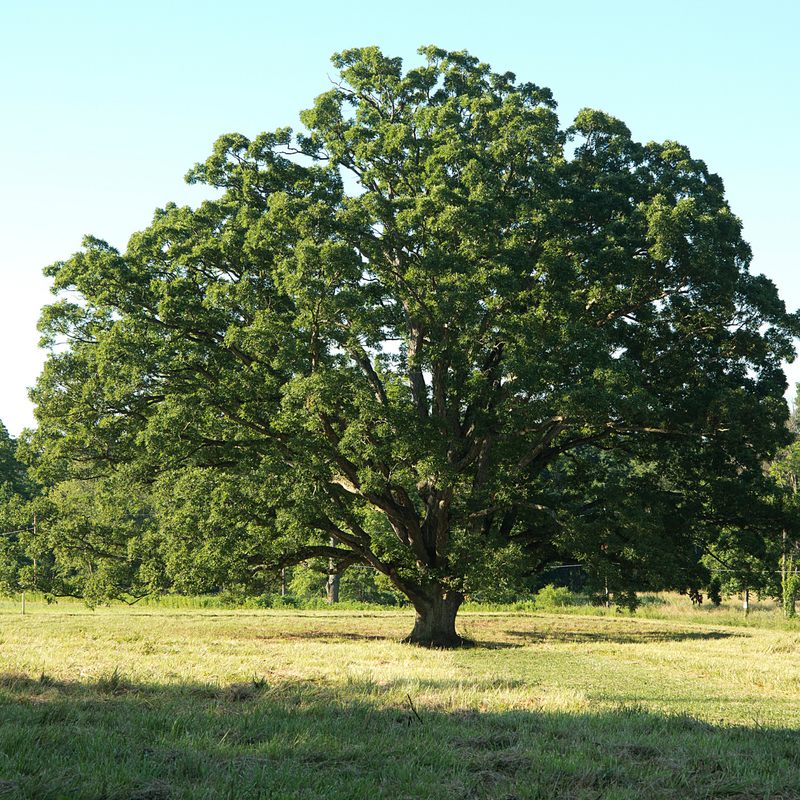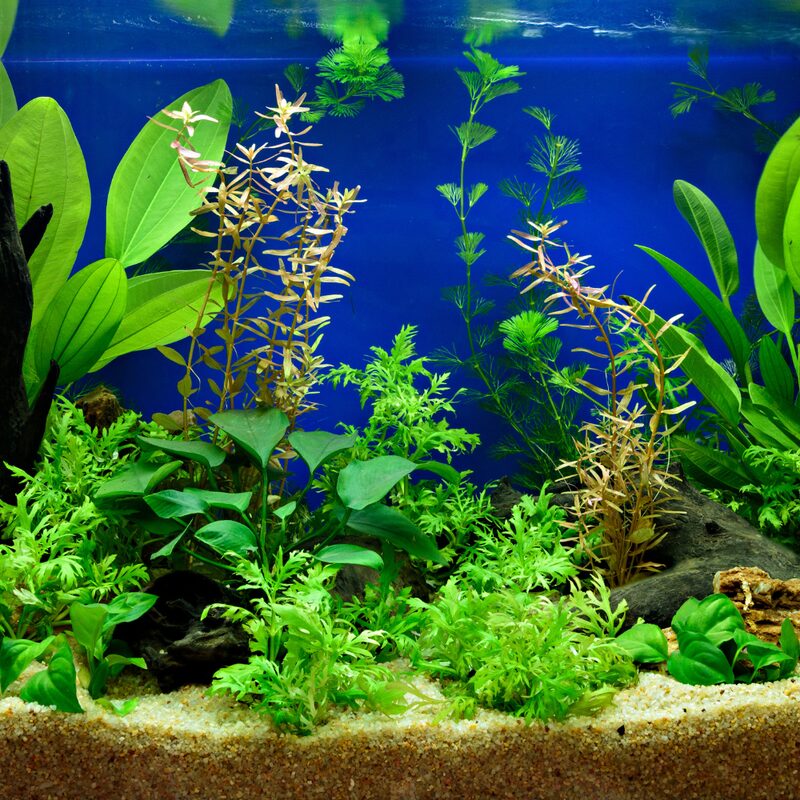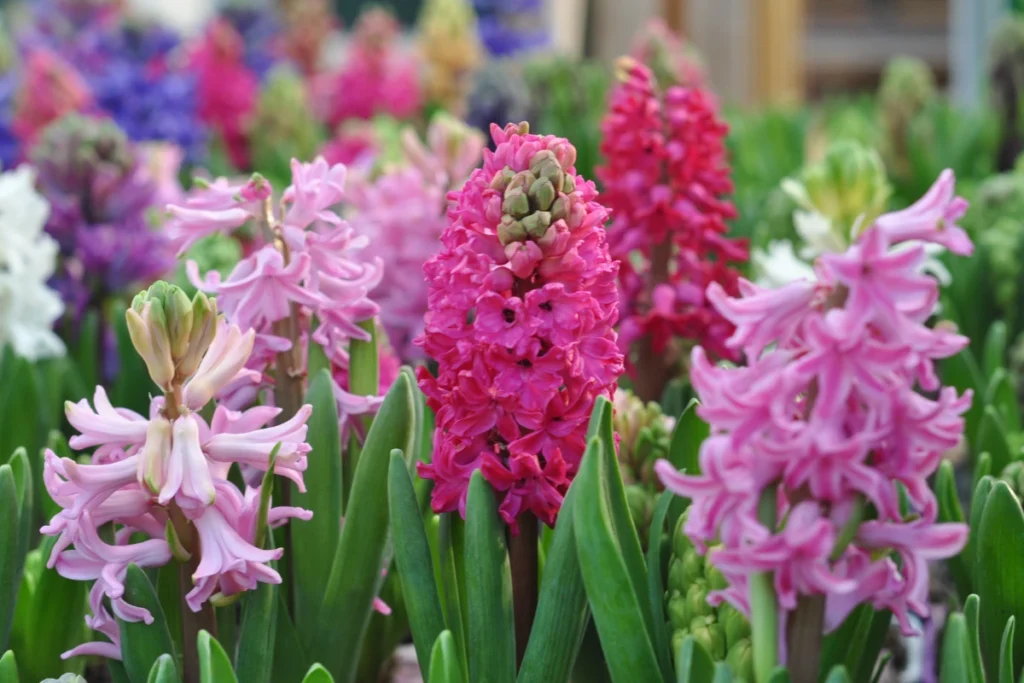Guide
Hyacinth Care: The Ultimate Guide to Growing Stunning Blooms
What is the Hyacinth Plant?
Hyacinths (Hyacinthus orientalis) are beloved spring-flowering bulbs known for their vibrant colors and intoxicating fragrance. These plants add beauty and charm to any garden with their dense, cone-shaped flower clusters that come in shades of pink, purple, white, blue, and yellow. Their strong fragrance makes them a favorite choice for gardens, floral arrangements, and indoor displays.
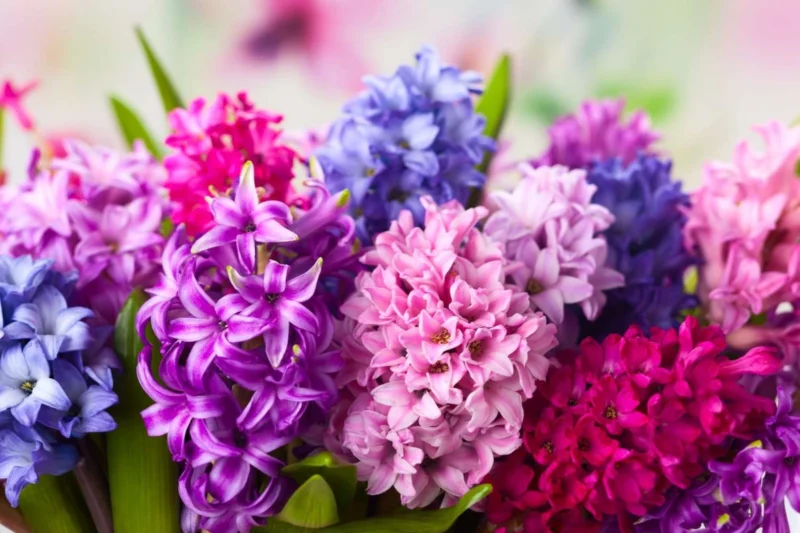
Native to the Mediterranean and parts of Asia, hyacinths thrive in well-drained soil and require a period of cold dormancy to bloom properly. They are commonly grown in gardens, pots, and even indoors through bulb forcing techniques. With proper care, hyacinths can be a long-lasting addition to your garden, returning each spring with their stunning blooms.
Key Features
-
Scientific Name: Hyacinthus orientalis
-
Plant Type: Perennial bulb
-
Bloom Time: Spring
-
Sunlight Requirements: Full sun to partial shade
-
Soil Type: Well-draining, slightly alkaline
-
Fragrance: Strong, sweet scent
-
Toxicity: Toxic to pets and humans if ingested
Planting the Hyacinth
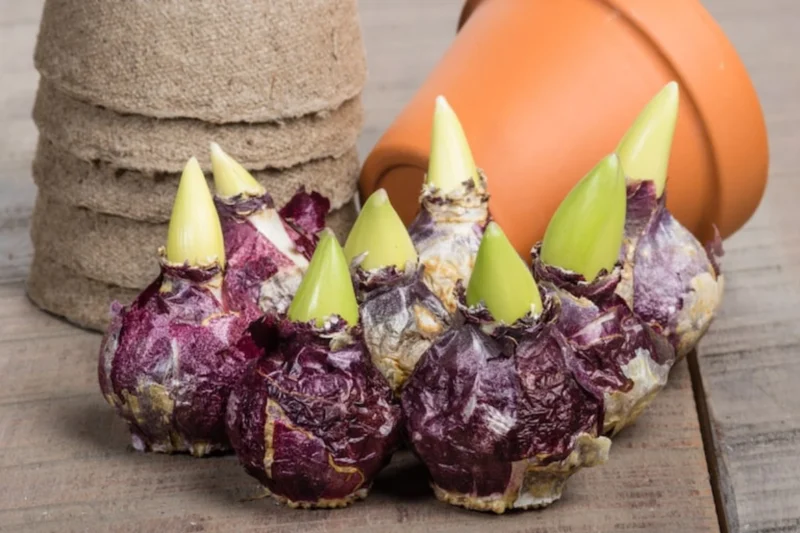
Best Time to Plant Hyacinths
The best time to plant hyacinth bulbs is in the fall, before the ground freezes. This timing ensures that the bulbs experience the necessary cold dormancy period, allowing them to develop strong root systems and produce vibrant blooms in early spring. Depending on your location, the ideal planting time is from September to November.
Choosing the Right Location
Hyacinths thrive in locations that receive at least six hours of direct sunlight each day. While they can tolerate partial shade, full sun exposure ensures the most robust and colorful flowers. Avoid planting hyacinths in low-lying areas where water may accumulate, as excessive moisture can lead to bulb rot.
Soil Preparation
Hyacinths prefer well-draining soil with a pH level of 6.0 to 7.5. To improve soil quality, incorporate organic matter such as compost or well-rotted manure. If your soil is heavy or clay-based, consider adding sand or perlite to enhance drainage. Proper soil preparation is essential to prevent root rot and support healthy growth.
Planting the Hyacinth
-
Dig a hole about 6-8 inches deep.
-
Place the bulb with the pointed end facing up to ensure proper growth.
-
Space bulbs 4-6 inches apart to allow for adequate air circulation and prevent overcrowding.
-
Cover with soil and water lightly to help settle the bulb.
-
Apply mulch to insulate the soil, retain moisture, and protect the bulbs from extreme winter temperatures.
Container Planting Tips
If planting in containers, choose a pot with good drainage holes and use a light, well-draining potting mix. Space bulbs closer together than in garden beds, but avoid overcrowding to allow room for growth. Containers should be stored in a cool, dark place for 10-12 weeks to mimic the winter chilling period before being moved to a sunnier location for blooming.
Growing Hyacinths
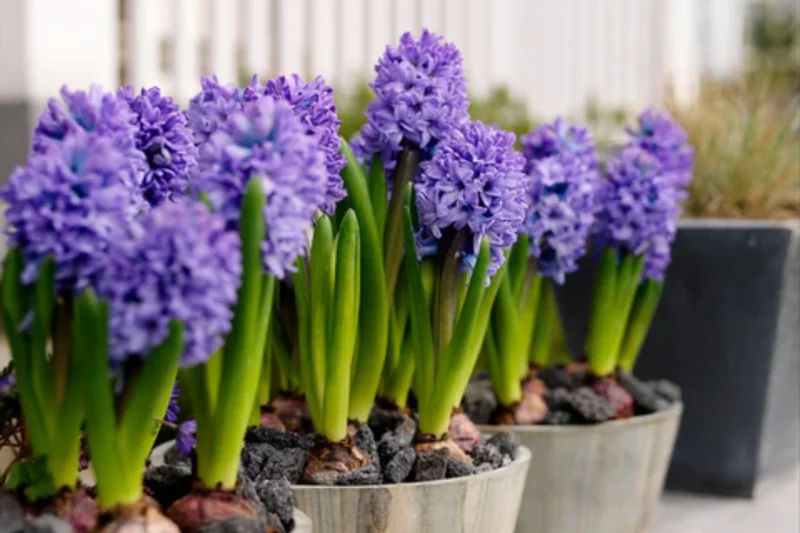
Watering
Hyacinths require moderate watering. The soil should remain slightly moist but never soggy. Overwatering can cause bulb rot, while underwatering can lead to stunted growth and weak blooms. During active growth, water the plants when the top inch of soil feels dry. Once the flowers fade and the foliage begins to yellow, reduce watering gradually to allow the bulbs to enter dormancy.
Fertilizing
For optimal growth, apply a balanced bulb fertilizer at planting time and again in early spring when shoots appear. Avoid using fertilizers high in nitrogen, as they promote excessive foliage growth at the expense of flower production.
Pruning and Deadheading
After the flowers fade, cut the flower stalks down to the base to prevent the plant from using energy to produce seeds. However, leave the foliage intact until it naturally turns yellow and withers. This process allows the bulb to store energy for the next growing season.
Seasonal Hyacinth Care Tips
-
Fall: Plant new bulbs, apply mulch, and prepare for winter.
-
Winter: Protect bulbs from extreme cold by adding a layer of mulch or moving potted plants to a sheltered area.
-
Spring: Water as needed, fertilize, and deadhead spent flowers.
-
Summer: Allow the foliage to die back naturally, dig up and store bulbs if desired.
Potting and Repotting
If growing hyacinths indoors, repot bulbs every one to two years to refresh the soil and provide nutrients. After flowering, bulbs can be stored and replanted in the fall for the next growing season.
How to Propagate Hyacinths
Hyacinths propagate through bulb offsets (baby bulbs) that develop at the base of the main bulb. To propagate:
-
After the foliage dies back, carefully dig up mature bulbs.
-
Separate small offsets from the main bulb.
-
Replant the offsets in the fall, ensuring they are properly spaced and planted at the correct depth.
-
It may take 2-3 years for offsets to produce flowers, so patience is key.
How to Get Hyacinths to Bloom
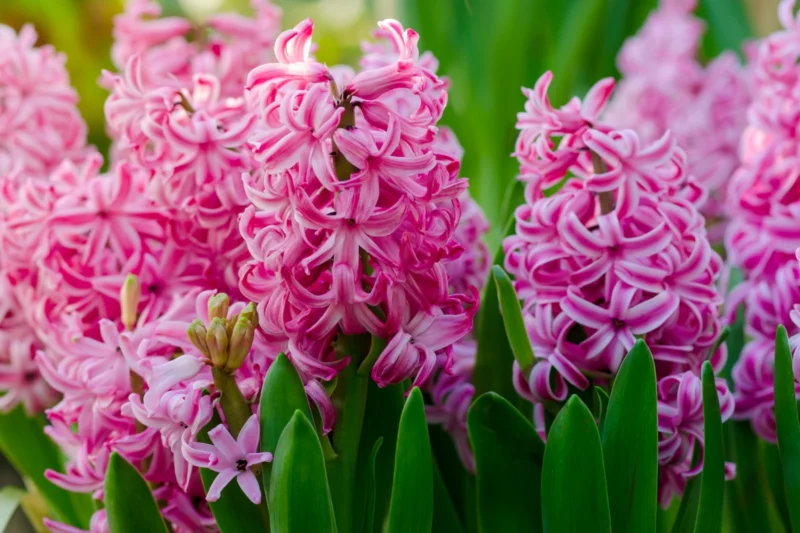
Bloom Months
Hyacinths typically bloom in mid-spring, from March to April. The blooms can last for several weeks, extending into late April or early May, depending on the weather conditions.
What Do Hyacinth Flowers Look and Smell Like?
Hyacinth flowers feature long, bright green leaves and bell-shaped petals. These blooms come in a wide range of colors, including white, blue, purple, pink, and red. Their sweet floral fragrance is incredibly strong, making them a favorite for garden beds, pots, and indoor displays. Hyacinths also pair well with other spring-blooming bulbs, such as tulips and daffodils, creating a visually stunning and aromatic combination in gardens.
How to Encourage More Blooms
Hyacinth bulbs are naturally low-maintenance and bloom without much intervention. However, to ensure continued strong blooms each year, consider these tips:
-
Cut down flower stalks once the blooms fade to direct energy back into the bulb.
-
Allow the leaves to yellow naturally before trimming them away, as they help store energy for the next season.
-
Feed the bulbs with a balanced fertilizer after they bloom and again in late summer (August) to provide essential nutrients.
-
Replant or lift and divide bulbs every two to three years to prevent overcrowding and maintain strong flowering.
Since hyacinths are hybrid bulbs, they gradually lose vigor over time. Replacing older bulbs with new ones every few years helps ensure that your garden remains full of healthy, vibrant blooms.
Growing Hyacinths in Water
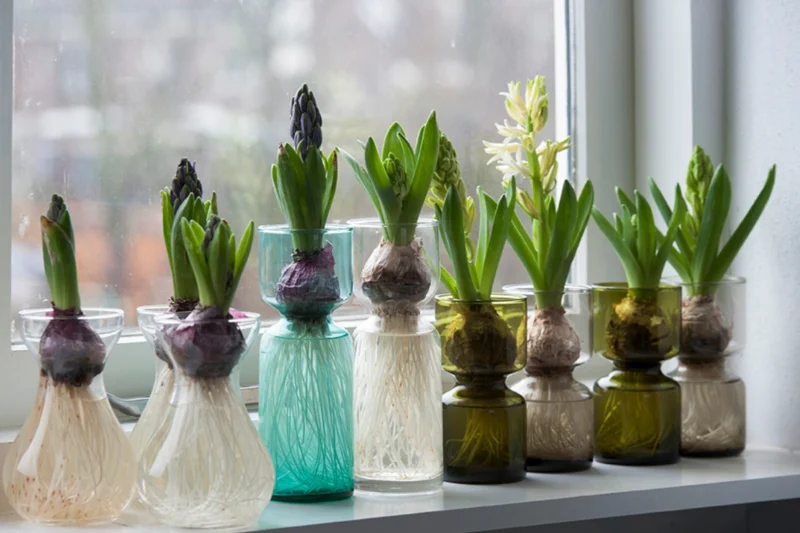
If you don’t have garden space or prefer an alternative way to grow hyacinths, you can cultivate them in glass jars or vases without using any soil. This method is not only decorative but also a great way to observe root development.
How to Grow Hyacinths in Water
-
Select the Right Bulbs: Use only heat-treated bulbs, as they are prepared for indoor forcing and will bloom without soil.
-
Choose a Glass Container: A clear jar or vase works best. It should have a narrow opening to support the bulb while allowing the roots to grow freely.
-
Add Water: Fill the container with fresh, clean water just below where the base of the bulb will sit. The bulb should not touch the water but should be positioned just above it.
-
Cool and Dark Period: Place the container in a cool, dark area (below 50°F or 10°C) for about six weeks. This encourages root formation and mimics the natural chilling period required for blooming.
-
Monitor Growth: Once the main green shoot is about 7-10 cm tall, move the container into full light and watch the flower gradually develop.
-
Rotate the Container: Turn the glass a few degrees every day to prevent the plant from leaning too much toward the light source and toppling over.
-
Maintain Water Levels: Check the water level regularly and top up as necessary, ensuring the base of the bulb does not sit in water to avoid rot.
Growing hyacinths in water is an excellent way to enjoy their beauty indoors, especially during the winter months when outdoor gardening options are limited. Plus, their stunning blooms and strong fragrance add a refreshing touch to any space!
Troubleshooting Hyacinth Problems
Even with proper care, hyacinths can sometimes develop issues. Below are some common problems gardeners face and how to resolve them.
Common Problems
No Blooms?
If your hyacinths fail to bloom, the most likely cause is that the bulbs did not receive enough chilling time during their dormant period. Hyacinths require at least 10-12 weeks of cold temperatures (between 35-45°F) to develop properly. If planted too shallowly, the bulbs may also struggle to produce flowers. Ensure they are planted at a depth of 6-8 inches for best results.
Additionally, bulbs that are too old or crowded may stop producing flowers. If your hyacinths have bloomed for a few seasons but suddenly stop, consider lifting, dividing, and replanting them.
Yellowing Leaves?
If the leaves of your hyacinths turn yellow prematurely, several factors could be responsible:
-
Overwatering: Excess moisture can cause bulb rot, leading to yellow leaves and poor growth.
-
Poor Drainage: If the soil does not drain well, the roots may become waterlogged and oxygen-starved.
-
Nutrient Deficiency: A lack of essential nutrients, particularly nitrogen, can result in weak foliage. Fertilize your hyacinths with a balanced bulb fertilizer after they bloom to ensure they receive the nutrients they need.
If yellowing occurs after blooming, it is a natural process. The leaves will die back as the plant stores energy for next year’s blooms.
Weak Stems?
If your hyacinth stems are floppy or weak, this could be due to insufficient sunlight or overcrowding. Hyacinths require at least six hours of direct sunlight per day to grow strong, upright stems. If they are in partial shade, consider relocating them to a sunnier spot.
Overcrowding can also lead to weak stems, as the bulbs compete for nutrients and space. If your hyacinths are growing too closely together, lift and separate the bulbs every two to three years.
Pests and Diseases
Bulb Rot
Bulb rot is a common issue caused by excess moisture and poor drainage. Symptoms include soft, mushy bulbs and a foul odor. To prevent this:
-
Plant hyacinths in well-draining soil.
-
Avoid overwatering and ensure the planting area does not retain excess moisture.
-
Remove and dispose of any rotting bulbs to prevent the spread of disease.
Aphids and Mites
These small pests can weaken hyacinths by sucking sap from leaves and stems, causing distorted growth. To control infestations:
-
Use insecticidal soap or neem oil.
-
Introduce natural predators, such as ladybugs, to keep aphid populations in check.
-
Regularly inspect plants and remove affected leaves if necessary.
Fungal Diseases
Fungal infections, such as botrytis blight and root rot, can cause spots, moldy growth, and wilting. To minimize fungal problems:
-
Avoid overhead watering and water at the base of the plant to keep foliage dry.
-
Provide good air circulation by properly spacing bulbs.
-
Apply a fungicide if necessary, especially in humid conditions.
Recommended Hyacinth Varieties
Hyacinths come in a variety of colors and forms, making it easy to find a type that suits your garden aesthetic. Below are some of the most popular and highly recommended hyacinth varieties:
Traditional Hyacinths (Hyacinthus orientalis)
- ‘Carnegie’ – A classic white hyacinth that grows up to 12 inches tall and produces snow-white flowers in early spring.
- ‘China Pink’ – Features soft pink blooms with delicate streaks of hot pink on the petals, adding a warm touch to spring gardens.
- ‘City of Haarlem’ – This variety offers soft yellow blooms, creating a lovely contrast with other spring flowers.
- ‘Hollyhock’ – Notable for its exceptional fragrance and double hot pink blooms, making it a standout in any garden.
- ‘Peter Stuyvesant’ – An early spring bloomer with deep blue-purple flowers, perfect for adding rich color to garden beds.
- ‘Gypsy Queen’ – A unique heirloom variety dating back to 1927 with salmon-pink blooms and an old-world charm.
- ‘Woodstock’ – Displays deep maroon flowers on 12-inch stems, providing a striking, dramatic look in garden borders.
Grape Hyacinths (Muscari)
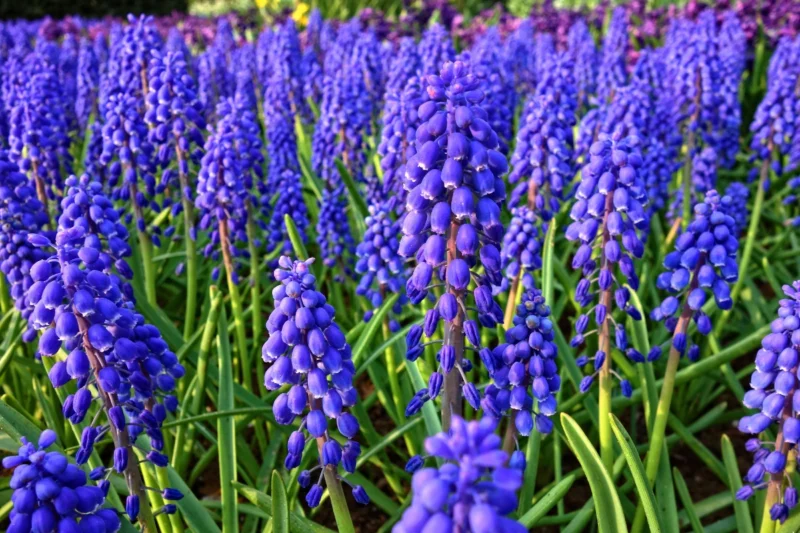
- ‘Viper Bow’ – A type of grape hyacinth (Muscari), ideal for naturalizing in garden beds and borders. It produces deep blue flowers on compact plants that grow 4 to 6 inches tall.
These hyacinth varieties are excellent for spring gardens, indoor forcing, and cut flower arrangements. They can be mixed with tulips, daffodils, and other spring-blooming bulbs for a colorful and fragrant display.
FAQs About Hyacinths
Q1: Are hyacinths safe for pets?
No, hyacinths are toxic to cats and dogs if ingested. The bulbs contain calcium oxalate crystals, which can cause severe irritation, vomiting, and digestive issues. Keep them out of reach of pets and children.
Q2: Can I grow hyacinths indoors?
Yes! You can grow hyacinths indoors by using the forcing method, which involves chilling bulbs for 10-12 weeks before planting them in pots. Ensure they receive bright indirect sunlight to bloom successfully.
Q3: Do hyacinths come back every year?
Yes, hyacinths are perennials, meaning they return each spring. However, their blooms may weaken over time. To maintain healthy flowers, lift and divide bulbs every two to three years and replenish with new bulbs as needed.
Q4: How do I store hyacinth bulbs?
After blooming, allow the foliage to die back naturally before digging up the bulbs. Brush off excess soil and store them in a cool, dry place in a breathable container, such as a mesh bag or paper sack. Replant in the fall for the next blooming cycle.
Final Thoughts
Hyacinths are an easy-to-grow, beautiful addition to any garden or home. With the right planting, watering, and care techniques, you can enjoy their vibrant blooms and sweet fragrance year after year. Whether you’re growing them in the ground or indoors, following these simple tips will ensure a thriving, fragrant display each spring.

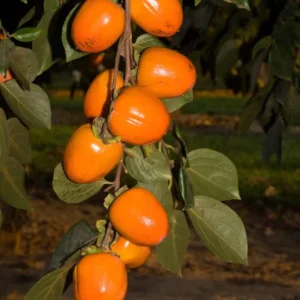 American Persimmon Tree in Pot, Hardy Fruit Tree for Zones 4-9, Persimmon Tree Live Plant, 6 to 12 Inch Tall
American Persimmon Tree in Pot, Hardy Fruit Tree for Zones 4-9, Persimmon Tree Live Plant, 6 to 12 Inch Tall 
